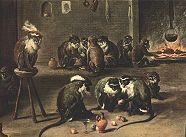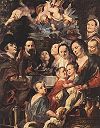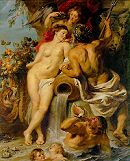
Feature Archive |
June, 2001
Rubens and his Age
| By Joseph Phelan |
 David Teniers Apes in the Kitchen (detail) | Toronto is enjoying a three month long visit of Treasures from the Hermitage at the Art Gallery of Ontario. The first of three exhibits from the State Hermitage Museum in St. Petersburg scheduled for the AGO over the next few years, Rubens and his Age focuses on the master painter and his circle of superb students and associates from the great period of Flemish Baroque Art. Apart from the rare opportunity to see works from the vaults of the Hermitage, many of which have never been exhibited outside Russia, the exhibit provides a wonderfully rich history lesson of the kind which only great paintings can teach us. |
| The 17th century was the last period of political and artistic greatness for Flanders. The southern Catholic part of the Netherlands, which had remained loyal to the Spanish Crown while Northern Holland successfully rebelled was soon strangled by their Northern neighbors and then stagnated until the late 19th century when an artist of the caliber of James Ensor and later Rene Magritte emerged from the rubble. For most of us Flemish Art is unknown territory, an undiscovered country from which no traveler has recently returned. Thus the exhibit asks us to take an imaginative leap into a time and place very different is some ways form the way we live now. |
| Peter Paul Rubens was the painter of the first part of the 17th Century in Catholic Europe. How he became so is an interesting story. |
| Rubens was educated to be a humanist but like all great artists choose his profession for himself. The combination of first-rate classical education with an innate visual genius made for an unprecedented combination in an artist. |
| Copying the masterpieces of the Italian Renaissance especially and the recently unearthed sculptures of classical antiquity, Rubens sketched and painted and encompassed all that was best in Italian and Classical art. Rubens combined the lessons of Antique Sculpture with the vaunting ambition of the High Renaissance giants in an unprecedented way. He used the plastic lessons of sculpture as a composition model but insisted that flesh should look like flesh in a painting thus developing his breakthrough approach to the naked body. In this he never forgot the earthy luminous realism of the old Netherlandish tradition of the 15th and 16th century (Van Eyck, Van Weyden, Breughel). You won't appreciate Rubens the master of the female nude until you consider that he was the greatest influence on French painting from the 18th to the 20th century: Watteau, Fragonard, Delacroix, and Renoir were his among his loyal followers. |
| Rubens was to develop a phenomenal ability to analyze the different styles of painting and sculpture and then synthesis them into whatever his clients wanted. His clients included just about every Catholic monarch, as well as Catholic leaning Protestants like King Charles I of England, and every major religious order in Western Europe. Not to mention every wealthy connoisseur of painting. To satisfy an ever growing demand Rubens opened the largest art workshop Europe has ever seen: he would paint an small initial oil sketch which when approved and contracted for would be given over to one or more of his students to paint the full length canvas, finally Rubens would add the finishing touches and sign it. Thus he became both a teacher and a hugely successful businessman. |
| Rubens went to England to negotiate a peace treaty with the King of England and Spain and while there became a favorite of the court of King Charles I - as did his most brilliant student, Anthony Van Dyck, in the next decade. The marvelous work of Van Dyck are well represented in this exhibit, including the brilliant religious painting of Christ Showing His Wounds, his own self-portrait, and a final gallery devoted to his English portraits. |
| Peace, harmony, abundance, and love these are the great themes of Rubens and his age, which this exhibit illustrates so well. I have not begun to tell you about all the wonderful still lives, flower paintings and genre scenes in the exhibit from less well known artists working within Rubens circle. |
| Take this as a very good introduction to Rubens and Van Dyck, to Catholic Europe in the 17th Century and finally to the Hermitage that great museum which Catherine the Great founded in the 18th century. |
Rubens and his Age: Through August 12 at the Art Gallery of Ontario
This article is copyright 2001 by Joseph Phelan. Please do not republish any portion of this article without written permission.
Joseph Phelan can be contacted at joe.phelan@verizon.net
Past Articles
May, 2001
Great Reproductions of Great Paintings
April, 2001
The Passion of Christ, by Joseph Phelan
March, 2001
Edouard Manet: Public Spaces, Private Dreams, by Joseph Phelan
February, 2001
Henry Moore and the British Museum: The Great Conversation, by Joseph Phelan
December, 2000
Advent Calendar 2000, narrated by Joseph Phelan
November, 2000
Article: Notorious Portraits, Part II, by John Malyon
October, 2000
Article: Notorious Portraits, Part I, by John Malyon
Article: The Other Michelangelo, by Joseph Phelan
September, 2000
Article: The Art of Drawing, by Joseph Phelan
August, 2000
Article: Poussin and the Heroic Landscape, by Joseph Phelan
July, 2000
Article: Great Art Museums Online, by Joseph Phelan
June, 2000
Article: Venetian Painting and the Rise of Landscape, by Joseph Phelan
May, 2000
Article: Forbidden Visions: Mythology in Art, by Joseph Phelan
April, 2000
Article: Themes in Art: The Passion of Christ, by Joseph Phelan
Web site review: Christus Rex
March, 2000
Web site review: National Gallery of Art, Washington, D.C., by Joseph Phelan
Online exhibit review: Inuit Art: The World Around Me, by John Malyon
February, 2000/Poll: Who is Producing the Most Interesting Art Today? (Results)
January, 2000/Poll: Who is Producing the Most Interesting Art Today? (Part II)
December, 1999/Poll: Who is Producing the Most Interesting Art Today? (Part I)
November, 1999/The Louvre Museum
Web site review: The Louvre
October, 1999/Impressionism
Web site review: North Carolina Museum of Art
September, 1999/Optical Art
Web site review: The Butler Institute of American Art
August, 1999/Animals in Art
Web site review: National Museum of Wildlife Art
Online exhibit review: PBS: American Visions
July, 1999/Surrealism
June, 1999/Sculpture
Web site review: Carol Gerten's Fine Art
Online exhibit review: Michael Lucero: Sculpture 1976-1995
May, 1999/Women in the Arts
Web site review: National Museum of Women in the Arts
Online exhibit review: Jenny Holzer: Please Change Beliefs
April, 1999/The Golden Age of Illustration
Web site review: Fine Arts Museums Of San Francisco
Online exhibit review: Treasure Island and Robinson Crusoe online
March, 1999/Vincent van Gogh
Web site review: Van Gogh Museum, Amsterdam
Web site review: The Vincent van Gogh Information Gallery
February, 1999/Great Art
Web site review: The State Hermitage Museum, St. Petersburg, Russia
Online exhibit review: John Singleton Copley: Watson and the Shark


